
The Trans-Siberian Railway, historically known as the Great Siberian Route and often shortened to Transsib, is a large railway system that connects European Russia to the Russian Far East. Spanning a length of over 9,289 kilometers, it is the longest railway line in the world. It runs from the city of Moscow in the west to the city of Vladivostok in the east.

The Eurasian Land Bridge, sometimes called the New Silk Road, is the rail transport route for moving freight and passengers overland between Pacific seaports in the Russian Far East and China and seaports in Europe. The route, a transcontinental railroad and rail land bridge, comprises the Trans-Siberian Railway, which runs through Russia and is sometimes called the Northern East-West Corridor, and the New Eurasian Land Bridge or Second Eurasian Continental Bridge, running through China and Kazakhstan. As of November 2007, about one percent of the $600 billion in goods shipped from Asia to Europe each year were delivered by inland transport routes.

Khasan is an urban locality in Khasansky District of Primorsky Krai, Russia. It is located near the tripoint on the Tumen River where the borders of Russia, China and North Korea converge. Population: 742 (2010 Census); 795 (2002 Census); 1,187 (1989 Soviet census).
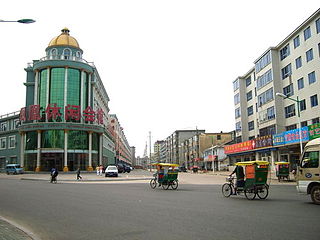
Hunchun is a county-level city in the Yanbian Korean Autonomous Prefecture, far eastern Jilin province. It borders North Korea and Russia, has over 250,000 inhabitants, and covers 5,145 square kilometers. The site of the eastern capital of the Balhae Kingdom between 785 and 793, Donggyeong, was located here.
Tumangang-tong is a neighbourhood in Sonbong, Rason, North Korea, near the China–North Korea–Russia tripoint where the borders of the three countries converge. It is also the closest town in North Korea to the border with Russia, being located across the river from the Russian settlement of Khasan and the Chinese settlement of Fangchuancun. The Korea Russia Friendship Bridge connects Tumangang and Khasan and is the sole crossing point on the 17 km (11 mi) long North Korea–Russia border. Trains coming from and going to Russia are handled by Tumangang Station.
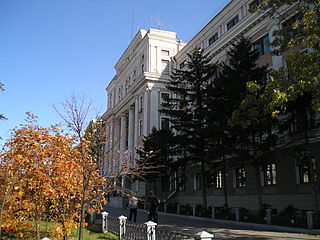
Far Eastern Railway is a railway in Russia that crosses Primorsky Krai, Khabarovsk Krai, Amur Oblast, Jewish Autonomous Oblast, and Yakutia.
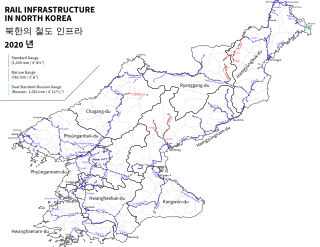
Rail transport in North Korea is provided by Korean State Railway which is the only rail operator in North Korea. It has a network of over 6,000 km of track, of which the vast majority is standard gauge; there is, however, nearly 400 km of narrow gauge lines (762 mm) in various locations around the country.

The Korean State Railway, commonly called the State Rail, is the operating arm of the Ministry of Railways of North Korea and has its headquarters at P'yŏngyang. The current Minister of Railways is Chang Jun-song.
Rajin station is a railway station in Rajin-guyŏk, Rasŏn Special City, North Korea. It is the junction point and terminus of both the Hambuk and P'yŏngra lines of the Korean State Railway. It is also the starting point of a freight-only branchline to Rajin Port station.

The Hambuk Line is an electrified standard-gauge trunk line of the Korean State Railway in North Korea, running from Ch'ŏngjin) on the P'yŏngra Line to Rajin, likewise on the P'yŏngra line.

The Hongŭi Line is an electrified standard-gauge secondary line of the North Korean State Railway running from Hongŭi on the Hambuk Line to Tumangang, which is the border station between North Korea and Russia. From Tumangang the line continues across the border to Khasan, Russia. The line from Tumangang to Rajin is double-tracked, including the entirety of the Hongŭi Line; during the recent renovation a 32 km section of dual Standard/Russian gauge was installed between Tumangang and Rajin stations. The entirety of the North Korean section of the line is located in Sŏnbong of Rasŏn Special City.
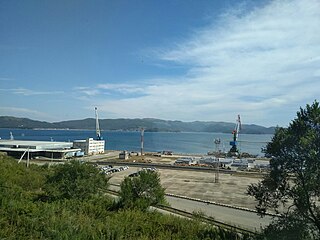
Port of Zarubino is a sea port situated in Zarubino on the south of Primorsky Krai in the Trinity Bay, northwestern part of the Sea of Japan. The port is 18 kilometres (11 mi) from the border with China and close to the border with North Korea. A railway line from the port connects to railway lines running north to Vladivostok, west to Hunchun of Jilin Province in China where a high speed rail terminus is operational, and south to Rajin in North Korea via Khasan, respectively. It is ice-free year round.
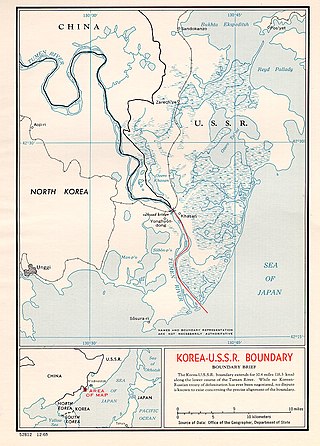
The North Korea–Russia border, according to the official Russian definition, consists of 17.3 kilometres (10.7 mi) of "terrestrial border" and 22.1 km of "maritime border". It is the shortest of the international borders of Russia.
Jilin–Hunchun intercity railway, also known as Jihun Passenger Dedicated Line, is a high-speed railway operated by China Railway High-speed in Jilin Province. It connects the major city of Jilin City with the eastern city of Hunchun near the border with Russia and North Korea. It will have a total length of 359 km (223 mi) of electrified double-track railways, built to the Grade 1 standard. Project construction started on October 30, 2010, with operations commencing on September 20, 2015. The railway has been described as "Dongbei's most beautiful railway" and "the fastest way to Vladivostok". Reflecting the border location of the city, the new train station has its sign in four languages: Chinese, Korean, Russian, and English. Future prospects could see the line extended to Vladivostok.

Tumangang station is a railway station in Tumangang-rodongjagu, Sŏnbong, Rasŏn Special City, North Korea, on the Hongŭi Line of the Korean State Railway.
Hongŭi station is a railway station in Hongŭi-ri, Sŏnbong, Rasŏn Special City, North Korea; it is the junction point of the Hongŭi and Hambuk lines of the Korean State Railway.

The Yaroslavsky suburban railway line is one of eleven railway lines used for suburban railway connections between Moscow, Russia, and surrounding areas, mostly in Moscow Oblast. The Yaroslavsky suburban railway line connects Moscow with the stations in the northeast, in particular, with the towns of Mytishchi, Korolyov, Ivanteyevka, Fryazino, Shchyolkovo, Pushkino, Krasnoarmeysk, Sergiyev Posad, Strunino, and Alexandrov. The stations the line serves are located in Moscow, as well as in the towns of Mytishchi, Kaliningrad, Shchyolkovo, Ivanteyevka, Fryazino, Noginsk, Pushkino, Krasnoarmeysk, and Sergiyev-Posad in Moscow Oblast, as well as Alexandrovsky District of Vladimir Oblast. The suburban trains have their southwestern terminus at Moscow Yaroslavsky railway station in Moscow. In the northeastern direction, the suburban trains terminate at Bolshevo, Fryazino Passazhirskaya, Monino, Shchyolkovo, Fryazevo, Pushkino, Sofrino, Krasnoarmeysk, Sergiyev Posad, Alexandrov, and Balakirevo. The line is served by the Moscow Railway subsidiary of Russian Railways and the Central Suburban Passenger Company.

The Korea–Russia Friendship Bridge is a rail bridge over the Tumen River. It was commissioned in 1959 as a replacement for a temporary wooden bridge. Located immediately downstream from the China–North Korea–Russia tripoint, the bridge is the sole crossing point on the 17 km long North Korea–Russia border. Planks are laid between the tracks making crossing of road vehicles possible by special arrangement, but it is primarily a rail bridge. The tracks are dual gauge because the Russian railroad system uses a track gauge of 1,520 mm while the North Korean system uses 1,435 mm. The bridge is served by the Khasan railway station on Russian soil and Tumangang Station on the North Korean side of the river.
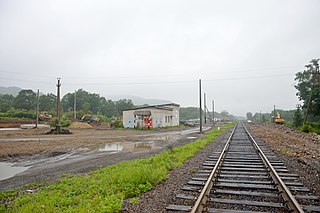
The Baranovsky–Khasan line is about 240 km of Far Eastern Railway within Russian Railways. It leads from Trans-Siberian Railway in the south of Baranovsky along the coast of Pacific Ocean to the North Korean border in Khasan. Its continuation is the Tumangang Line. The route is mainly operated by regional trains that connect places along the route with Ussuriysk, where there is a connection with the Trans-Siberian Railway, or with the regional centers of Vladivostok and Khabarovsk.

Khasan railway station is a railway station on the Baranovsky-Khasan railway line in the village of Khasan, Khasansky District, Primorsky Krai, Russia. It belongs to the Vladivostok branch of the Far Eastern Railway. It is the last station in Russia before the line continues into North Korea.














